Download the MNF Year in Review 2024-25:
CSIRO acknowledges the Traditional Owners of the land, sea and waters, of the area that we live and work on across Australia. We acknowledge their continuing connection to their culture and pay our respects to their Elders past and present.
View our vision towards reconciliation.
Marine National Facility
Year-in-Review 2024-25
About the MNF
 The Marine National Facility (MNF) is Australia’s dedicated ocean research capability, enabling vital marine and atmospheric research across our vast marine estate. Funded by the Australian Government, including funding from the National Collaborative Research Infrastructure Strategy (NCRIS), the MNF is operated by CSIRO, Australia’s national science agency, on behalf of the nation.
The Marine National Facility (MNF) is Australia’s dedicated ocean research capability, enabling vital marine and atmospheric research across our vast marine estate. Funded by the Australian Government, including funding from the National Collaborative Research Infrastructure Strategy (NCRIS), the MNF is operated by CSIRO, Australia’s national science agency, on behalf of the nation.
The MNF comprises the advanced ocean‑class research vessel (RV) Investigator, a suite of scientific equipment, technical staff and expertise, and more than 40 years of freely available marine data. Operation of the MNF is overseen by an independent Steering Committee and sea time on RV Investigator is awarded by independent advisory committees through a competitive application process.
RV Investigator is a highly productive piece of Australian research infrastructure. It provides a science-ready platform to meet the diverse and multidisciplinary science needs of the marine research community to enable research for national benefit. It provides an impressive capability for oceanographic, biological, atmospheric and geophysical research, as well as maritime heritage studies. In addition, the vessel provides a vital platform for training our future marine stewards and inspiring interest in our marine environment through the delivery of important maritime education and training activities.
RV Investigator can accommodate a research team of 40 participants, stay at sea for 60 days, and cover up to 10,000 nautical miles per voyage. The vessel can operate anywhere from the Antarctic ice edge to the tropics.
With the delivery in 2020 of the 10-year strategy, MNF 2030, the MNF is fulfilling its mission to facilitate safe, efficient and excellent marine and atmospheric research to address the challenges facing Australia’s society, economy and environment. RV Investigator is funded to deliver full year research operations until 2027–28.
From the Chair
 In my second year as Chair of the CSIRO Marine National Facility (MNF) Steering Committee, I continue to be impressed by the work and output of the MNF and its collaborators in marine research. Reflecting on the past 12 months, the highlights provided in this Year in Review again demonstrate why the MNF is one of Australia’s most important research infrastructure capabilities, delivering essential ocean research data to support long-term scientific research and policy development. These benefits extend from researchers and their institutions to governments and industry.
In my second year as Chair of the CSIRO Marine National Facility (MNF) Steering Committee, I continue to be impressed by the work and output of the MNF and its collaborators in marine research. Reflecting on the past 12 months, the highlights provided in this Year in Review again demonstrate why the MNF is one of Australia’s most important research infrastructure capabilities, delivering essential ocean research data to support long-term scientific research and policy development. These benefits extend from researchers and their institutions to governments and industry.
In a year when scheduled dry docking and maintenance tasks had research vessel (RV) Investigator in port for long periods of time, the MNF was still able to deliver a range of research and achieve science outcomes of significant national benefit and impact. Furthermore, the MNF operates in an incredibly challenging physical and logistical environment. The team delivers complex voyage schedules that include an array of multidisciplinary research projects, partners and collaborators. Many of these voyages are conducted in some of the most remote and extreme environments on the planet.
It is through the combined expertise, enthusiasm and commitment of the MNF team, to support both safety and scientific excellence, that this sustained and impressive record of achievement has been possible.
In 2024–25, the MNF delivered a wide range of scientific research to support Australia’s environmental, economic and social prosperity. Some of the benefits of this research include:
- advancing our understanding of how climate change affects Australia’s unique ecosystems and industries
- supporting the monitoring and protection of marine biodiversity and fragile ecosystems
- providing essential data to help secure Australia’s maritime territories
- enabling risk assessments for natural disasters impacting coastal communities, infrastructure and industries
- safeguarding food security and sustainable production in a changing global environment.
The diverse array of science highlighted in this Year in Review is a testament to the great expertise, efficiency and efforts of these outstanding teams of people. I commend the team in the MNF and our incredible ship officers and crew for their commitment to delivering excellent marine science in collaboration with Australia’s researchers and their international partners.
I am excited and proud to be able to share this Year in Review with you.
Anne-Marie Lansdown
Chair, MNF Steering Committee
From the Director
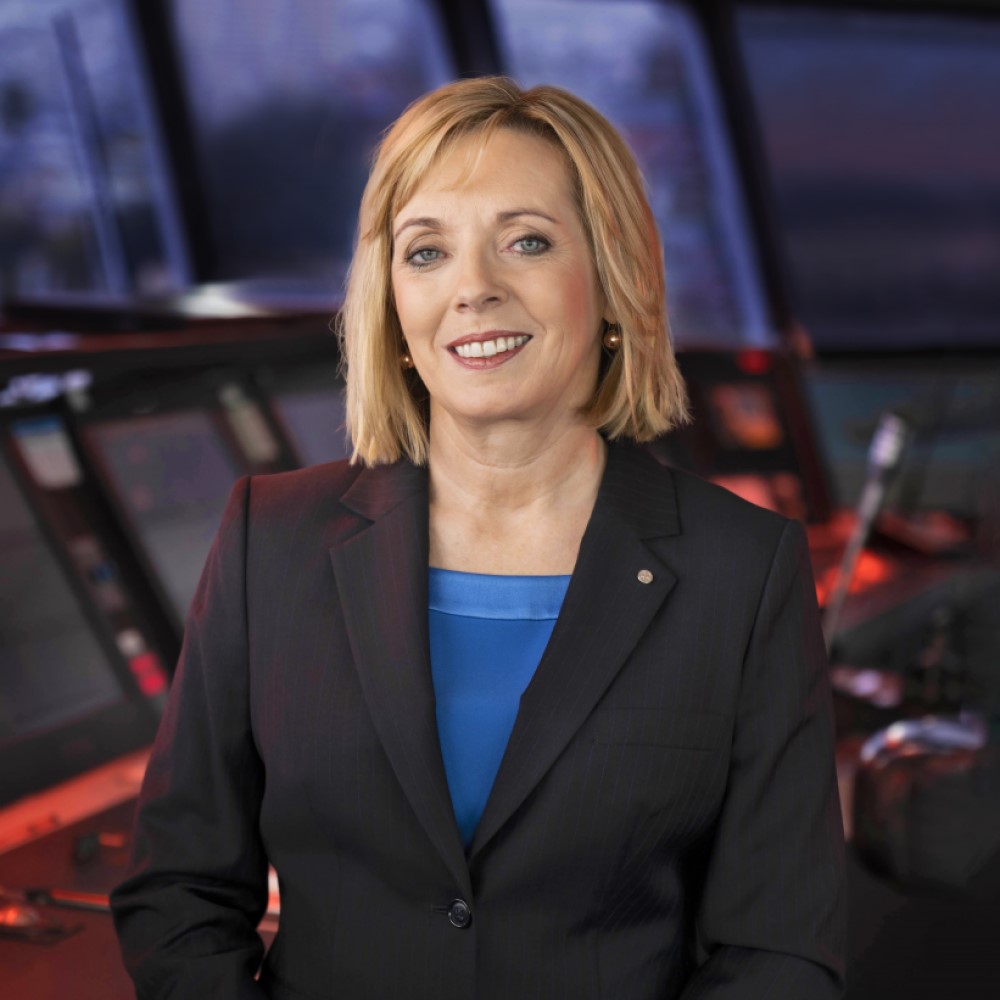 It’s safe to say that there is never a quiet year in the CSIRO Marine National Facility (MNF) and 2024–25 has been another example of that. It has been an incredible year of achievements, including a celebration of 10 years of RV Investigator, and developments for our nation’s dedicated blue-water research facility.
It’s safe to say that there is never a quiet year in the CSIRO Marine National Facility (MNF) and 2024–25 has been another example of that. It has been an incredible year of achievements, including a celebration of 10 years of RV Investigator, and developments for our nation’s dedicated blue-water research facility.
The MNF is foundational research infrastructure for Australia. It provides trusted expertise, equipment and systems and creates a collaboration hub for researchers from across multiple disciplines to deliver research for national benefit.
Most importantly, the research we deliver, fostered through innovation and collaboration, furnishes our collective knowledge to support evidence-based decision-making by government, industry, researchers and our society to ensure the protection and prosperity of Australia’s vast and diverse marine estate.
Combined with our research achievements, the MNF has a deep commitment to providing excellent education and training opportunities to build our national scientific literacy and future generations of marine experts. This is demonstrated through programs such as CAPSTAN, the Collaborative Australian Postgraduate Sea Training Alliance Network, which offers at sea training for university students, and the Indigenous Time at Sea Scholarship, which offers at sea training for Indigenous students. These programs deliver learning opportunities for all voyage participants and are crucial for fostering the relationships, partnerships and discussions that are needed to advance and improve the way we approach our science.
The MNF proudly celebrated its 40th year of operation during 2024–25 and we continue to strive for best practice in all aspects of our work. We are committed to reconciliation and to growing and fostering meaningful change by ensuring Aboriginal and Torres Strait Islander people’s participation in marine research through opportunities to engage and lead research that affects them, and by incorporating Aboriginal and Torres Strait Islander knowledge systems into how research is conducted.
I am pleased to share this Year in Review with you to highlight just some of the many achievements of the MNF in 2024–25. Congratulations and thank you to all those, on ship and on shore, who made this year possible.
Toni Moate
Director, Marine National Facility
Celebrating 40 years of the MNF
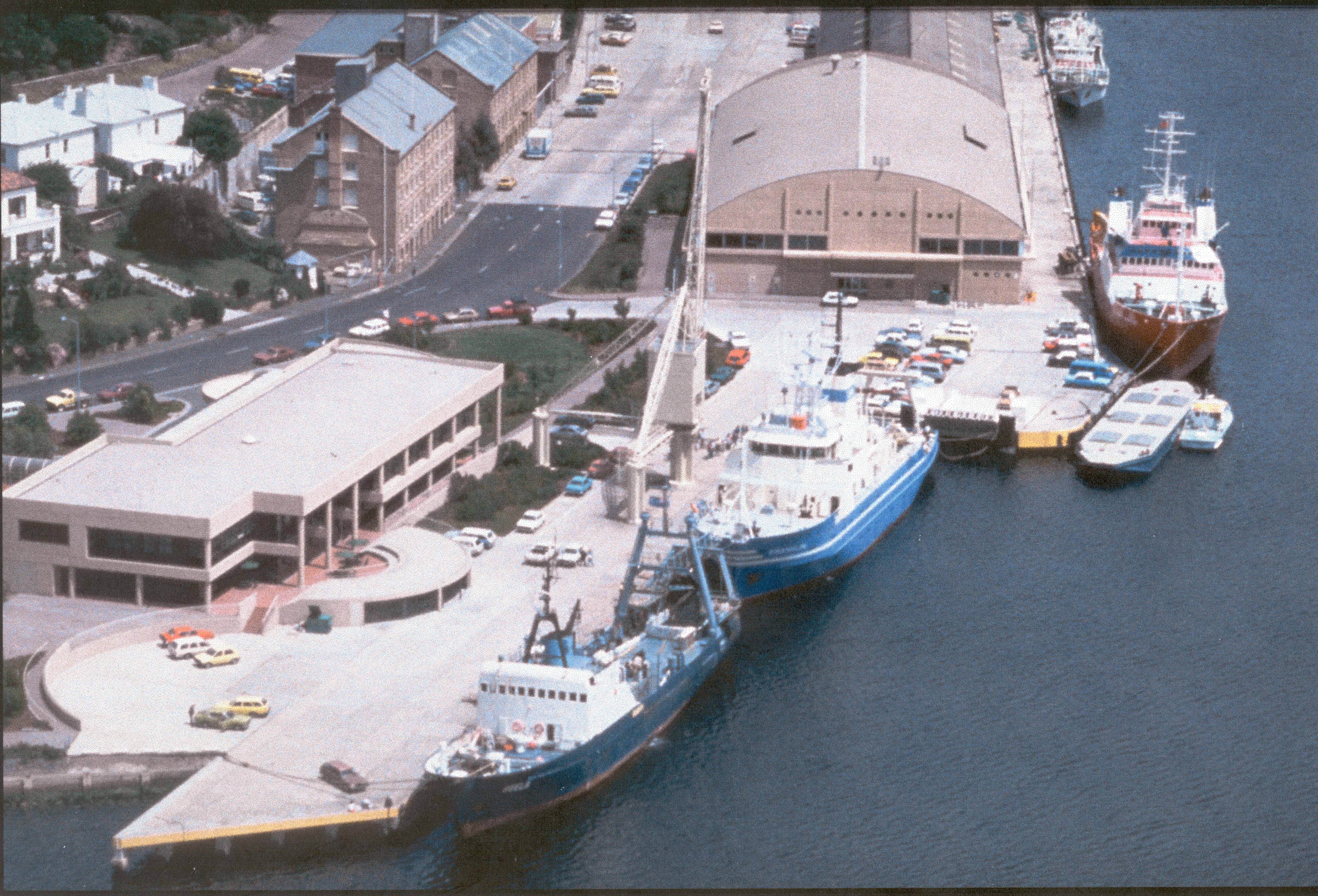 A significant milestone was reached during the past year as we celebrated the 40th anniversary of the official launch of the MNF. This anniversary also coincides with the launch of the MNF’s first ocean research vessel, ORV Franklin.
A significant milestone was reached during the past year as we celebrated the 40th anniversary of the official launch of the MNF. This anniversary also coincides with the launch of the MNF’s first ocean research vessel, ORV Franklin.
The MNF was established by the Australian Government to provide a dedicated ocean research capability to the Australian marine science community so they could deliver research for national benefit. Importantly, the MNF sought to give Australian scientists the capability to conduct research across the length, breadth and depth of Australia’s vast and largely unexplored marine estate.
Since it commenced official operation in 1985, the MNF has an impressive record in delivering vital marine data and furnishing knowledge to inform decision making by government, industry, the research sector and, most importantly, the Australian community.
We thank all who have contributed to this mission over the past 40 years and to all those at sea and on shore who continue to do so.
Enhancing our future capability
In 2024–25, the MNF commenced a program of capability upgrades to enhance operational performance and scientific support offered by RV Investigator. This included upgrades to vessel amenities and scientific capabilities.
Commencing during the vessel’s scheduled dry docking in 2024, the first phase of the middle of life (mid-life) refit saw the upgrade of RV Investigator’s suite of acoustic systems, including the shallow, mid and deep-water multibeam echosounders. The works included the mounting of the shallow-water system in the vessel’s gondola, making it permanently available for research (previously being added to a scientific drop keel, as needed). Modifications were made to several workspaces, including the Aerosol Laboratory and Hydrochemistry Laboratory, and the vessel’s primary communication and data link was upgraded to improve onboard connectivity.
Looking ahead, further enhancements will be delivered across scientific and operational spaces. These will include installation of a vertical sediment winch to allow deeper deployments, and the integration and commissioning of a new sidescan sonar system, generously donated to CSIRO by Fugro, to expand seabed mapping and underwater cultural heritage capabilities. Upgrades are also planned for the General Purpose Wet Laboratory (Dirty), the Preservation Laboratory, Aerosol Laboratory and Sheltered Science Area.
Integral to maintaining the best possible platform for meeting the nation’s marine research needs, the past year also saw the activation of the MNF Technology and Innovation Advisory Group, or TIAG for short. This group draws from the expertise of our marine research community to provide advice on the capability requirements that will ensure the vessel continues to meet the capability needs of the nation, now and into the future.
2024-25 snapshot
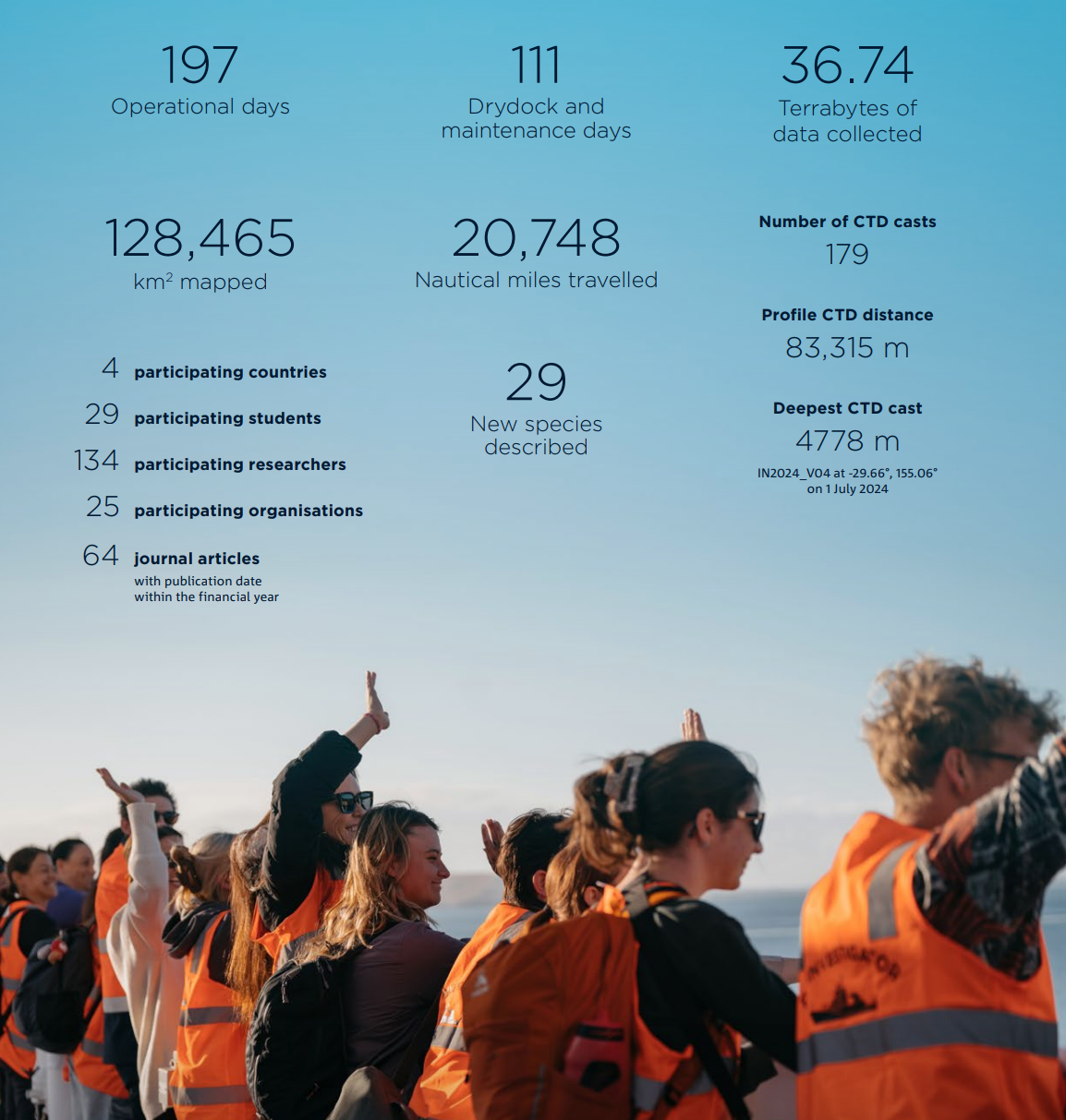
Research delivered and supported
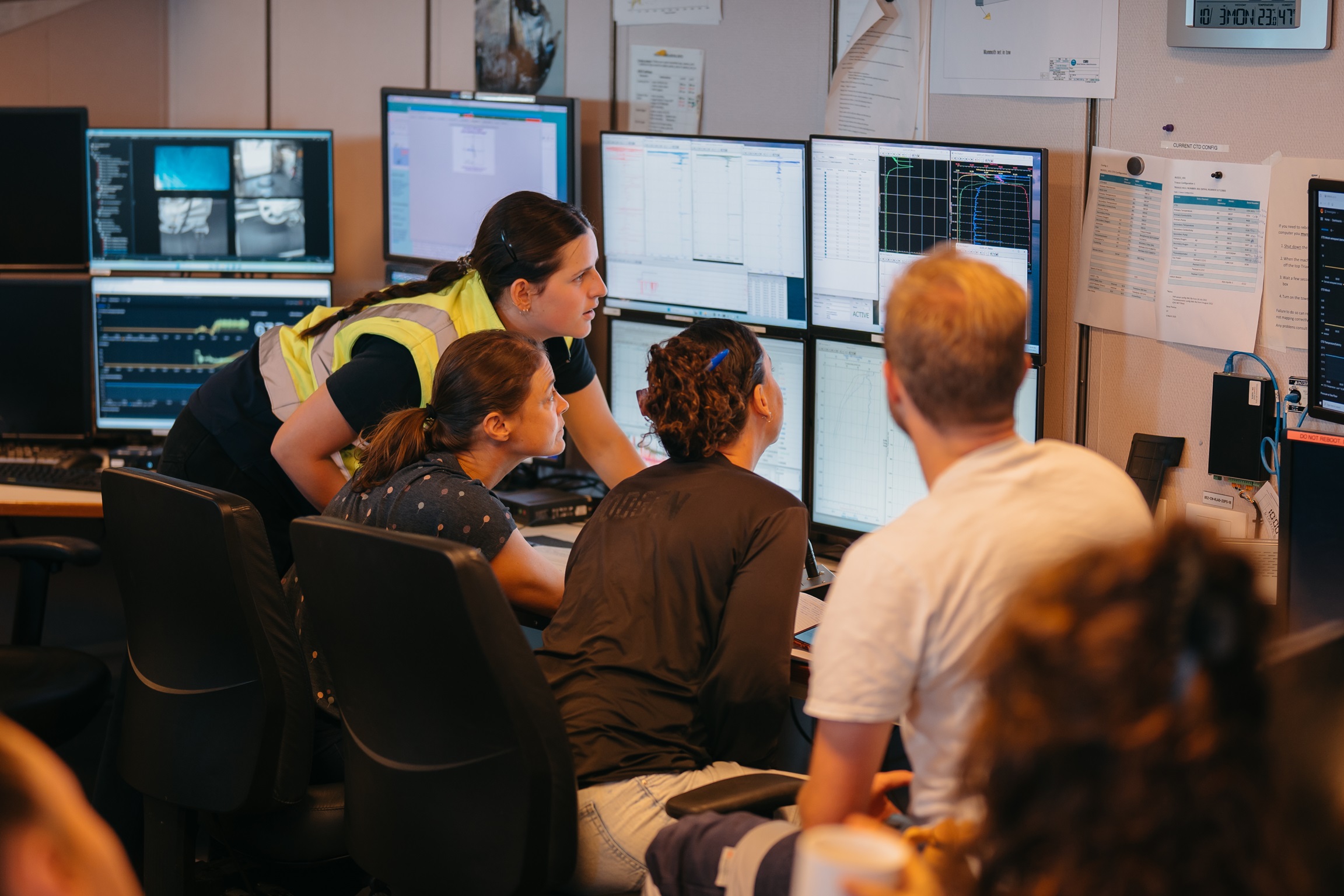 While RV Investigator spent time ‘out of water’ during the past year for dry docking and the start of the mid-life refit project, the research achievements were not diminished.
While RV Investigator spent time ‘out of water’ during the past year for dry docking and the start of the mid-life refit project, the research achievements were not diminished.
During 2024–25, RV Investigator travelled over 20,000 nautical miles – the equivalent of 3 circumnavigations of Australia – to deliver 9 voyages: 5 research voyages, 2 transit voyages and 2 sea trial and calibration voyages. Research voyages included primary projects related to atmospheric, biological and oceanographic science, along with additional projects related to these and geoscience and maritime heritage disciplines.
In addition to project research, all voyages include the collection of important underway data – atmospheric, geoscience and oceanographic data – which furnishes our understanding of Australia’s vast marine estate and contributes to national and international scientific programs and initiatives. The vessel also delivered several foundational training opportunities, including the postgraduate sea training program, CAPSTAN, and the Indigenous Time at Sea Scholarship.
The period saw the tally of species new to science, that RV Investigator voyages have helped describe, reach more than 165 new species. Twenty-nine new species were added to the list during 2024–25 including several high-profile announcements. Top of the list was the global interest in the announcement of the Carnarvon Flapjack Octopus described from specimens collected during a voyage in 2022. RV Investigator’s impressive capabilities for deep-sea discovery continues to turn wonder into discovery and capture the public interest.
Infrastructure delivering impact
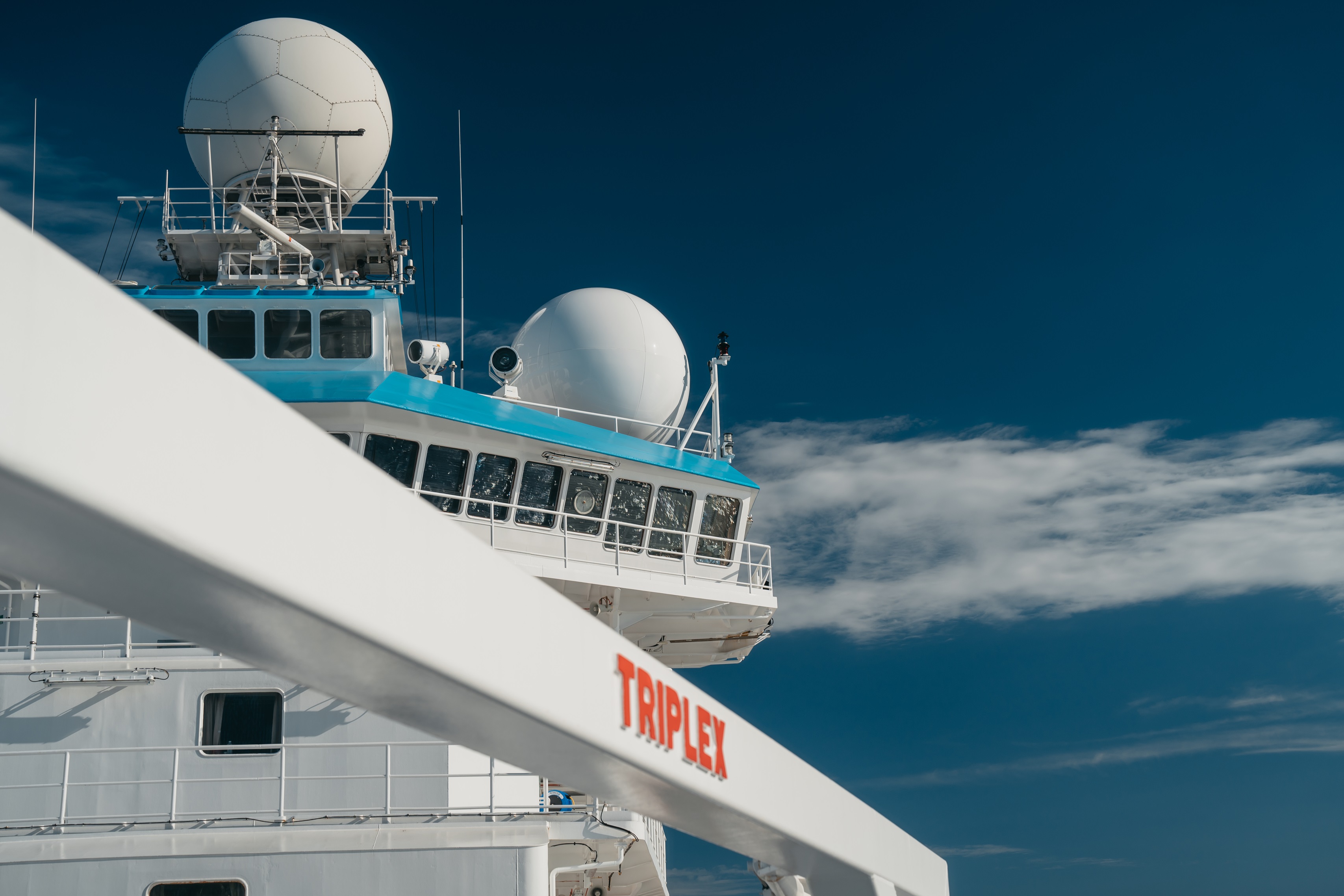 Since arriving in 2014, RV Investigator has delivered 118 voyages to 30 June 2025. These voyages cover the full length, breadth and depth of Australia’s vast marine estate – from the Antarctic ice edge to our tropical northern waters to our remote offshore territories such as Heard Island and the Indian Ocean Territories of Christmas and Cocos (Keeling) Islands.
Since arriving in 2014, RV Investigator has delivered 118 voyages to 30 June 2025. These voyages cover the full length, breadth and depth of Australia’s vast marine estate – from the Antarctic ice edge to our tropical northern waters to our remote offshore territories such as Heard Island and the Indian Ocean Territories of Christmas and Cocos (Keeling) Islands.
The research delivered by RV Investigator has a positive impact on improving our environment, economy and society.
In December 2024, the vessel celebrated its 10th anniversary of commissioning. With an unparalleled record of research since that time, an increasing number of research publications are being published each year. During 2024–25, there were 64 peer-reviewed research publications recorded, contributing to the increasing body of research outputs that are helping furnish our understanding of the Australian marine environment.
CASE STUDY 1: Catching ocean currents to increase shipping efficiency
Research undertaken across a series of voyages by collaborative research teams has collected intensive ocean measurements to help develop a robust model for forecasting ocean currents. This model, developed into a commercial application by the University of NSW, is revolutionary and potentially provides global shipping with a tool to operate more efficiently and avoid, or make use of, shifting ocean currents.
Application of this forecasting by more than 100 ships has demonstrated consistent fuel savings of up to 20%, leading to significant reductions in fuel costs, in travel times and, importantly, greenhouse gas emissions such as carbon dioxide.
Read more: Catch a current
CASE STUDY 2: Discovering and mapping life across the deep ocean
RV Investigator has provided marine biologists with unparalleled capability to conduct ocean exploration, especially of the deep ocean. Extensive biodiversity survey programs conducted by the vessel, alongside data collected by previous MNF research vessels, has enabled the collection of a vast array of biological specimens and the discovery of hundreds of new species, including the Carnarvon Flapjack Octopus which was announced in a paper in May 2025. Using these specimens, researchers have been able to investigate life in the deep ocean to better understand diversity and connectivity between regions.
This knowledge is vital for industry and marine managers to inform marine conservation assessments and increase our understanding of deep ocean ecosystems and their vulnerability.
Read more: New species list
Voyage map

Voyages delivered
JULY 2024
IN2024_T02 Transit voyage
MNF | 8 July to 23 July 2024 | Scheduled maintenance | Brisbane to Singapore
The objective of this 16-day voyage was to relocate RV Investigator to the Seatrium Shipyard in Singapore for its 5-yearly scheduled dry docking and commencement of vessel middle of life refit program.
SEPTEMBER 2024
IN2024_T03 Transit voyage
MNF | 7 September to 26 September 2024 |Scheduled maintenance | Singapore to Hobart
The objective of this 20-day voyage was to relocate RV Investigator to the vessel’s home port of Hobart following its 5-yearly scheduled dry docking and to
continue its middle of life refit program.
NOVEMBER 2024
 IN2024_V05 South-East Australian Marine Ecosystem Survey (SEA-MES) – Voyage III
IN2024_V05 South-East Australian Marine Ecosystem Survey (SEA-MES) – Voyage III
Untangling the causes of change over 25 years in the south-east marine ecosystem
Dr Rich Little, CSIRO | 13 November to 13 December 2024 | Biological science | Hobart to Hobart
The marine waters of south-east Australia are a significant and productive region of immense natural, social and economic value to the nation. However, they are also a global ocean-warming hotspot of growing concern for their management and prosperity.
As part of a multi-voyage project called SEA-MES, the South-East Australian Marine Ecosystem Survey, CSIRO researchers led this 31-day biological science voyage to document changes in the marine ecosystem. Researchers conducted a program of surveys to collect data to compare with similar surveys completed 30 years prior. The science party included 36 participants from 3 institutions. This was the third of 4 voyages in the SEA-MES program.
The voyage delivered vital data that will contribute to the overall SEA-MES program and its objectives. Importantly, in addition to documenting changes in the marine ecosystem on the continental shelf, the research is also establishing a baseline for documenting changes on the continental slope. The knowledge generated through this research is increasing our understanding of the impacts from climate change, informing planning and managing of marine industries in the region, and helping us protect important marine species and habitats.
MARCH 2025
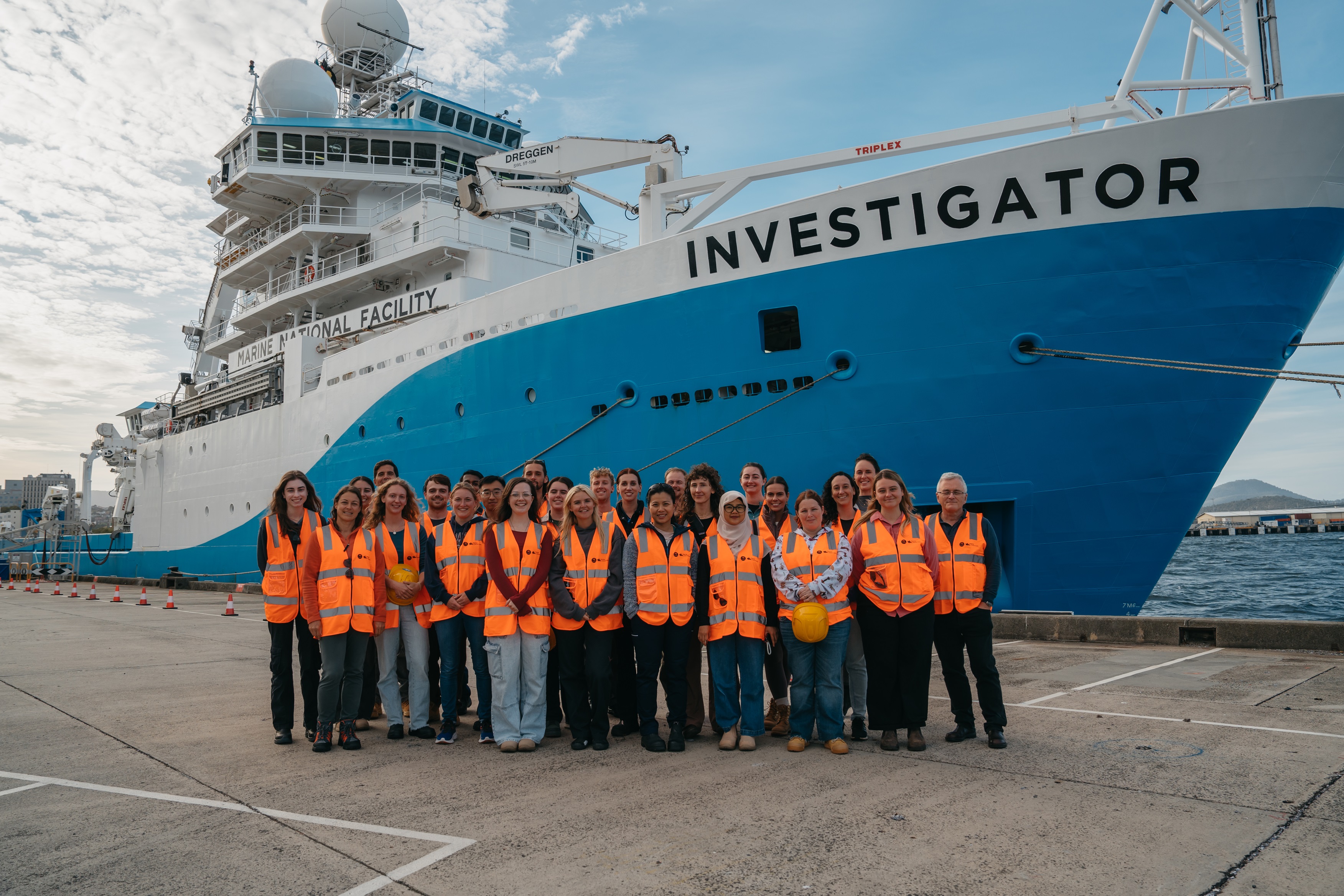 IN2025_V01 CAPSTAN 04 sea training voyage
IN2025_V01 CAPSTAN 04 sea training voyage
Training the next generation of marine experts for Australia
CAPSTAN Program, University of Tasmania | 8 March to 17 March 2025 | Maritime training | Hobart to Hobart
Australia’s ‘blue economy’ generates $229 billion each year in economic output and marine science is a critical discipline to support that. To help Australia fulfil its blue economy potential and prosper as a nation, marine science requires a multidisciplinary workforce. While Australian marine science training is world-class in many areas, few Australian universities offer multidisciplinary training that encompasses the full spectrum of marine science disciplines aligned with the needs of industry and government.
CAPSTAN is a first of its kind program in Australia that transforms the way marine science education is delivered. This 10-day voyage was the fourth in the CAPSTAN program overall. It included 38 participants and provided opportunities for 21 university students and 5 trainers to receive dynamic, hands-on practical training with the wide range of scientific systems and equipment available on RV Investigator.
Further, it provided opportunities for professional development and networking, as well as development of individual project management and leadership capabilities. The voyage has contributed to the development of a standardised curriculum for marine science education in Australia, aligning with new technologies, data collection tools and RV Investigator capabilities. In addition to the training outcomes, the voyage also contributed a range of important datasets and samples for various research programs, giving students the additional experience of assisting in real-world research through this exceptional
training program.
MARCH 2025
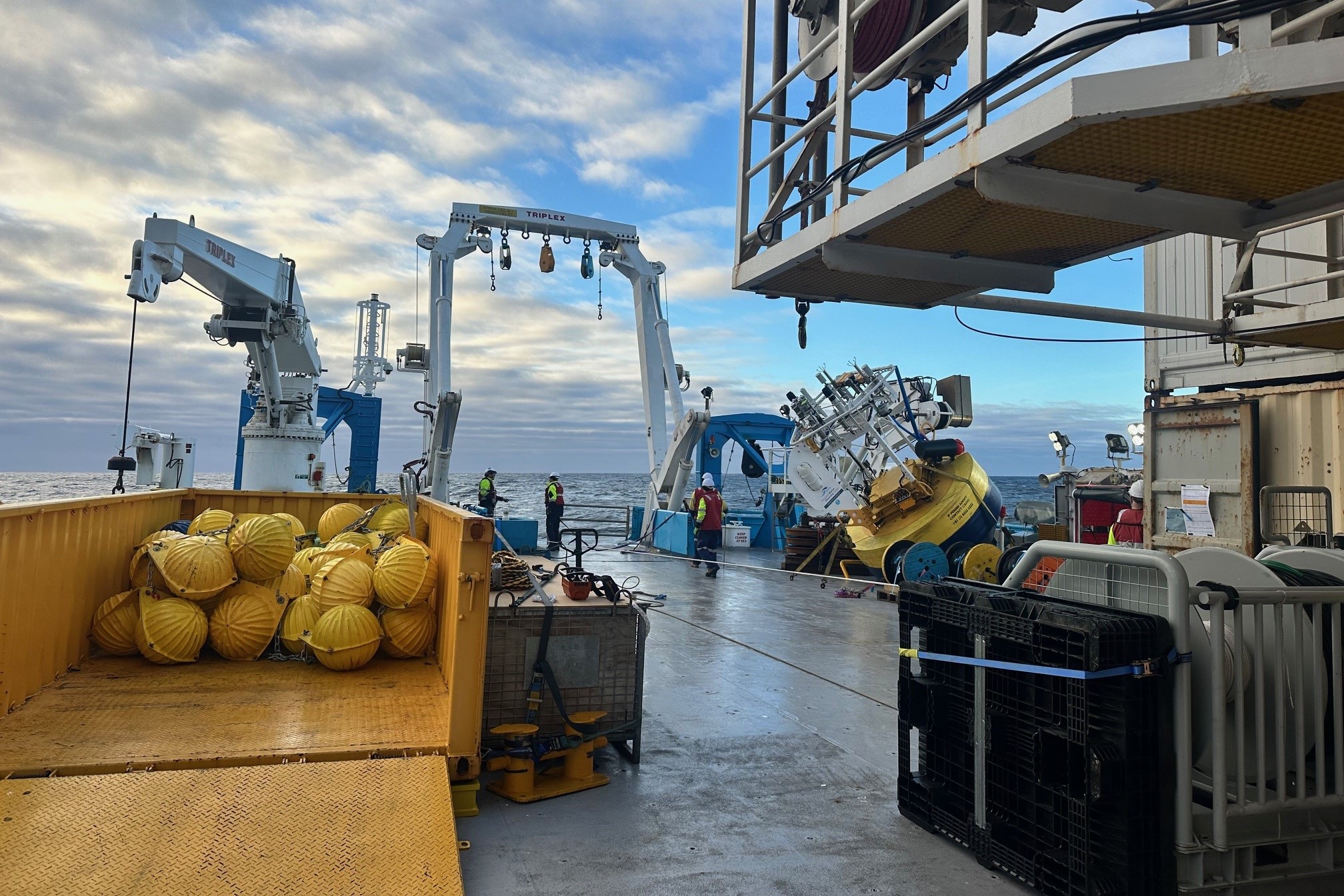 IN2025_V02 SOTS: automated moorings for climate and carbon cycle studies in the Southern Ocean
IN2025_V02 SOTS: automated moorings for climate and carbon cycle studies in the Southern Ocean
Maintaining the Southern Ocean Time Series (SOTS) automated moorings for long-term monitoring of the Southern Ocean
Dr Elizabeth Shadwick, IMOS | 26 March to 14 April 2025 | Oceanographic science | Hobart to Hobart
The Southern Ocean is a key region in the global climate system but we have only limited data to furnish our knowledge of how the ocean and atmosphere interact. Improved understanding is essential to enhance advice to the nation on climate variability affecting us now, develop future scenarios and impact assessments, and to make optimal decisions that will affect the nation’s future.
This 20-day voyage, part of a multi-voyage collaboration between the Integrated Marine Observing System (IMOS) and CSIRO, maintained the Southern Ocean Time Series (SOTS) deep-water moorings. Led by dual IMOS/CSIRO researchers, the science party of 22 participants from 3 institutions successfully
recovered and deployed the SOTS mooring array. In addition, the voyage delivered 6 additional projects across atmospheric, biological, geoscience and oceanographic disciplines.
As a result of this voyage, Australia continues to sustain the longest time series of Southern Ocean observations operated by any nation, contributing to the global effort to understand ocean dynamics and their role in climate and responses to anthropogenic emissions. This critical observing infrastructure provides an integrated and ongoing assessment of the seasonality of the processes that control air-sea exchanges important to climate, and upper ocean processes important to ocean productivity. This work is part of the OceanSITES global array of time series observations which is a network within the United Nations mandated Global Ocean Observing System.
APRIL 2025
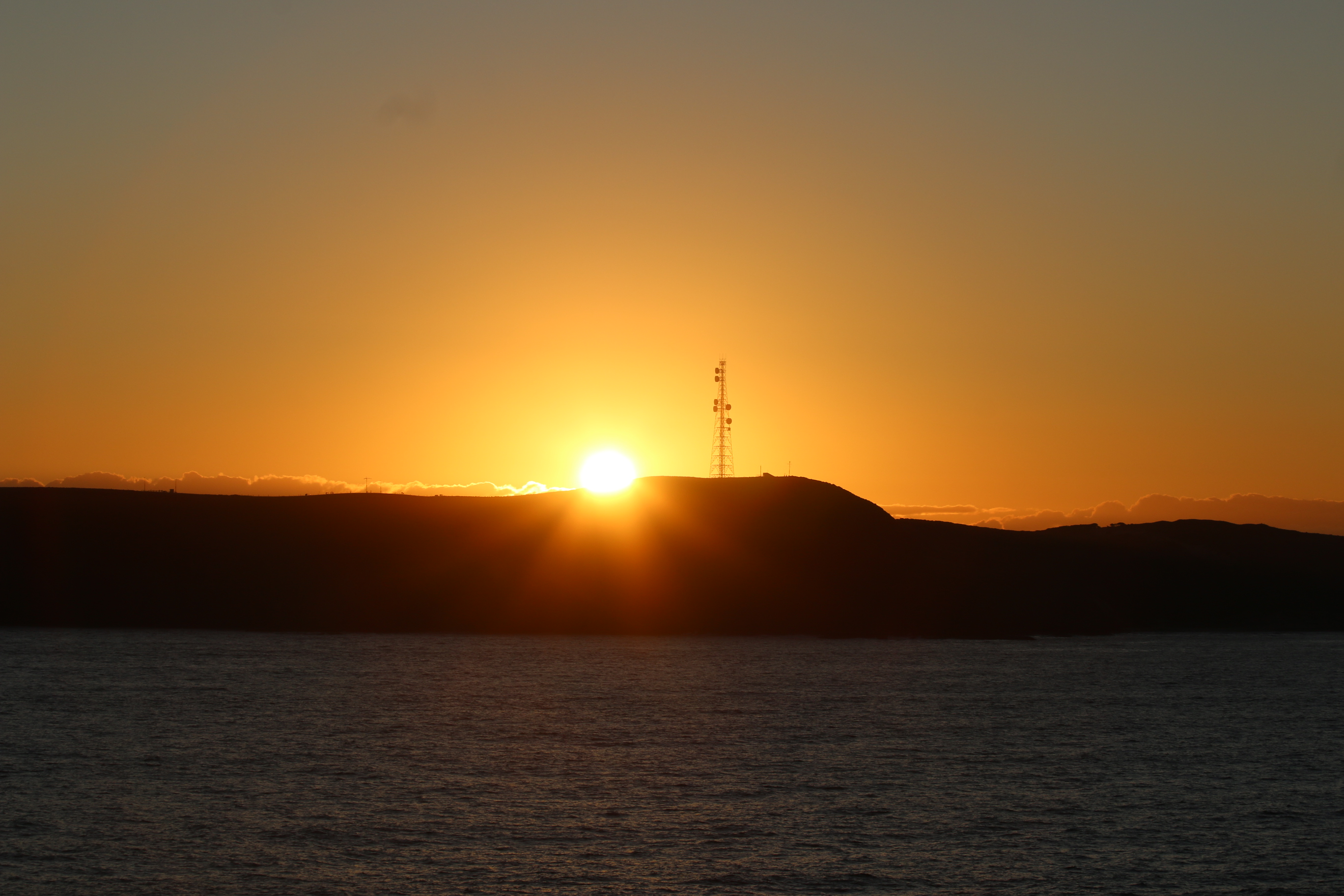
Understanding the influence of human activity on some of the cleanest air on the planet
Dr Ruhi Humphries, CSIRO | 29 April to 18 May 2025 | Atmospheric science | Hobart to Hobart
High-quality atmospheric datasets are critical for accurately predicting weather, climate, and air quality, which are essential for Australia’s economy, health, and wellbeing. This is particularly important in regions that are under-sampled, either in space or time, such as in the remote and operationally challenging environment of the Southern Ocean.
Led by CSIRO researchers, this ambitious 20-day atmospheric science voyage delivered vital data to better predict and understand the influence of human activity on the global atmosphere. The voyage enabled the international science party of 23 participants – including 5 students – from 8 institutions to directly compare, for the first time, two global atmosphere monitoring stations: RV Investigator and Kennaook/Cape Grim Baseline Air Pollution Station.
The data collected will support scientific and operational efforts to address national and international priorities, particularly in regions like the Southern Ocean and Antarctica, which are vital for global climate models and weather systems impacting Australia. In addition, there were 4 other research projects on this voyage gathering a variety of geophysical, oceanographic and atmospheric data, made possible by the extensive capabilities of RV Investigator.
MAY 2025
 IN2025_V04 South-East Australian Marine Ecosystem Survey (SEA-MES) – Voyage IV
IN2025_V04 South-East Australian Marine Ecosystem Survey (SEA-MES) – Voyage IV
Untangling the causes of change over 25 years in the south-east marine ecosystem
Dr Rich Little, CSIRO | 27 May to 28 June 2025 | Biological science | Hobart to Hobart
The marine waters of south-east Australia are a significant and productive region of immense natural, social and economic value to the nation. However, they are also one of a series of global ocean-warming hotspots of growing concern for their management and prosperity.
As part of a multi-voyage project called SEA-MES, the South-East Australian Marine Ecosystem Survey, CSIRO researchers led this 33-day biological science voyage to document changes in the marine ecosystem. Researchers conducted a program of surveys to collect data to compare with similar surveys completed 30 years prior. The science party included 34 participants from 3 institutions, including an Indigenous student joining through the MNF Indigenous Time at Sea Scholarship. This was the final of 4 voyages in the SEA-MES program.
The voyage delivered vital data that will contribute to the overall SEA-MES program and its objectives. Importantly, in addition to documenting changes in the marine ecosystem on the continental shelf, the research is also establishing a baseline for documenting changes on the continental slope. The knowledge generated through this research is increasing our understanding of the impacts from climate change, informing planning and managing of marine industries in the region, and helping us protect important marine species and habitats.
Collaboration for national benefit
Collaboration is integral to the success of the MNF. In 2024–25, our research partners included:
- Australian Antarctic Division
- Australian National University
- Australian and New Zealand International Scientific Drilling Consortium (ANZIC)
- Bureau of Meteorology
- CSIRO
- Deakin University
- Flinders University
- Geoscience Australia
- Institute for Marine and Antarctic Studies (University of Tasmania)
- Integrated Marine Observing System
- Macquarie University
- Monash University
- Parks Australia
- Queensland University of Technology
- University of Adelaide
- University of Melbourne
- University of New South Wales
- University of Newcastle
- University of Queensland
- University of Sydney
- University of Tasmania
- University of Technology, Sydney
- University of Western Australia
- University of Wollongong
- University of the Sunshine Coast
- Department of Primary Industries and Regional Development, Western Australia
- Karlsruhe Institute of Technology (Germany)
- Colorado State University (USA)
- University of Utah (USA)
CASE STUDY 3: Collaborating to put more of our seafloor on the map in 2024–25
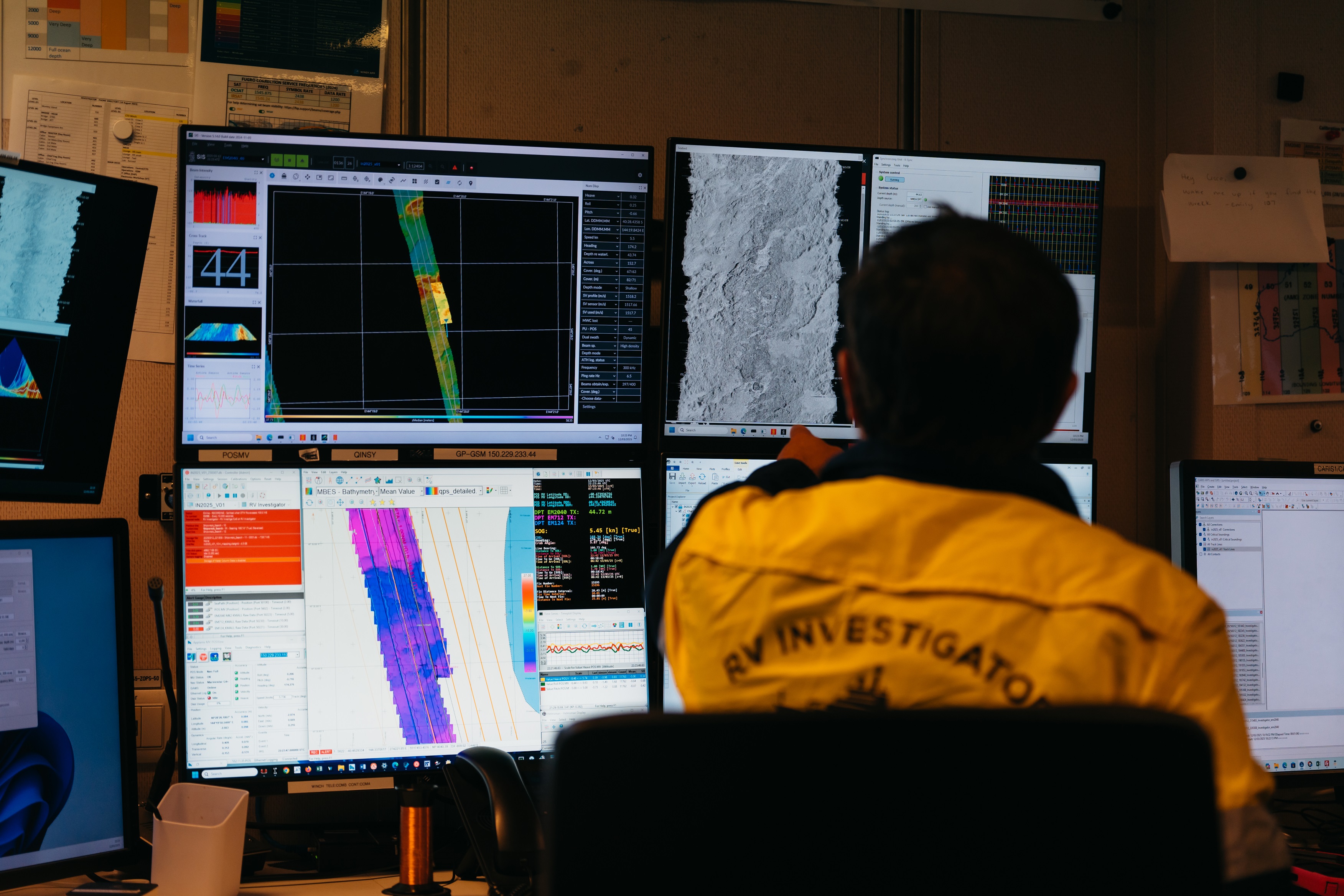
Since coming online in 2014, RV Investigator has made the single greatest contribution of any vessel to the AusSeabed program, Australia’s national seafloor mapping initiative led by Geoscience Australia. In 2024–25, RV Investigator provided 73% of the seabed mapping products into AusSeabed, totalling 523,726 km2 of mapped seafloor (from mapping conducted across various years). Overall, the seafloor mapping contributions made by RV Investigator have been instrumental in increasing the area of Australia’s Exclusive Economic Zone mapped to a modern standard from 25% in 2014 to 38.5% in 2025.
Further, the data provided through AusSeabed then makes an important contribution from Australia to Seabed 2030, the ambitious global program to map the entire seafloor by 2030. This highlights the significant contribution that RV Investigator makes not just at a national but also global scale.
This vital work is assisting in everything from securing Australia’s sovereign territory and facilitating safe navigation to better understanding our marine habitats and ensuring food security to uncovering submerged Indigenous landscapes.
Connecting with Australians
A key commitment of the MNF is to deepen community understanding and appreciation of the marine environment. During the past year, we delivered a diverse range of media, outreach and education activities that sought to engage the community with the wonder of our marine environment and the incredible science that we deliver in collaboration with our research partners.
Media and outreach highlights included sharing the story of the discovery of the wreck of the motor vessel, MV Noongah, a coastal freighter tragically lost at sea off Sydney in 1969; taking our immersive marine science cinema INVESTIGATE on the road to be stationed at the Queensland University of Technology campus in Brisbane’s CBD; reaching more than 3000 school students in an amazing new annual event to promote awareness about whales with MNF alum Dr Vanessa Pirotta; and achieving more than 2700 media items about our science that reached a national audience of nearly 8 million people.

Acknowledgements
The Marine National Facility (MNF) is funded by the Australian Government, including funding from the National Collaborative Research Infrastructure Strategy (NCRIS), and is operated by CSIRO, Australia’s national science agency, on behalf of the nation.
Download the MNF Year in Review 2024-25:
CSIRO acknowledges the Traditional Owners of the land, sea and waters, of the area that we live and work on across Australia. We acknowledge their continuing connection to their culture and pay our respects to their Elders past and present.
View our vision towards reconciliation.
Marine National Facility
Year-in-Review 2024-25
About the MNF
The Marine National Facility (MNF) is Australia’s dedicated ocean research capability, enabling vital marine and atmospheric research across our vast marine estate. Funded by the Australian Government, including funding from the National Collaborative Research Infrastructure Strategy (NCRIS), the MNF is operated by CSIRO, Australia’s national science agency, on behalf of the nation.
The MNF comprises the advanced ocean‑class research vessel (RV) Investigator, a suite of scientific equipment, technical staff and expertise, and more than 40 years of freely available marine data. Operation of the MNF is overseen by an independent Steering Committee and sea time on RV Investigator is awarded by independent advisory committees through a competitive application process.
RV Investigator is a highly productive piece of Australian research infrastructure. It provides a science-ready platform to meet the diverse and multidisciplinary science needs of the marine research community to enable research for national benefit. It provides an impressive capability for oceanographic, biological, atmospheric and geophysical research, as well as maritime heritage studies. In addition, the vessel provides a vital platform for training our future marine stewards and inspiring interest in our marine environment through the delivery of important maritime education and training activities.
RV Investigator can accommodate a research team of 40 participants, stay at sea for 60 days, and cover up to 10,000 nautical miles per voyage. The vessel can operate anywhere from the Antarctic ice edge to the tropics.
With the delivery in 2020 of the 10-year strategy, MNF 2030, the MNF is fulfilling its mission to facilitate safe, efficient and excellent marine and atmospheric research to address the challenges facing Australia’s society, economy and environment. RV Investigator is funded to deliver full year research operations until 2027–28.
From the Chair
In my second year as Chair of the CSIRO Marine National Facility (MNF) Steering Committee, I continue to be impressed by the work and output of the MNF and its collaborators in marine research. Reflecting on the past 12 months, the highlights provided in this Year in Review again demonstrate why the MNF is one of Australia’s most important research infrastructure capabilities, delivering essential ocean research data to support long-term scientific research and policy development. These benefits extend from researchers and their institutions to governments and industry.
In a year when scheduled dry docking and maintenance tasks had research vessel (RV) Investigator in port for long periods of time, the MNF was still able to deliver a range of research and achieve science outcomes of significant national benefit and impact. Furthermore, the MNF operates in an incredibly challenging physical and logistical environment. The team delivers complex voyage schedules that include an array of multidisciplinary research projects, partners and collaborators. Many of these voyages are conducted in some of the most remote and extreme environments on the planet.
It is through the combined expertise, enthusiasm and commitment of the MNF team, to support both safety and scientific excellence, that this sustained and impressive record of achievement has been possible.
In 2024–25, the MNF delivered a wide range of scientific research to support Australia’s environmental, economic and social prosperity. Some of the benefits of this research include:
- advancing our understanding of how climate change affects Australia’s unique ecosystems and industries
- supporting the monitoring and protection of marine biodiversity and fragile ecosystems
- providing essential data to help secure Australia’s maritime territories
- enabling risk assessments for natural disasters impacting coastal communities, infrastructure and industries
- safeguarding food security and sustainable production in a changing global environment.
The diverse array of science highlighted in this Year in Review is a testament to the great expertise, efficiency and efforts of these outstanding teams of people. I commend the team in the MNF and our incredible ship officers and crew for their commitment to delivering excellent marine science in collaboration with Australia’s researchers and their international partners.
I am excited and proud to be able to share this Year in Review with you.
Anne-Marie Lansdown
Chair, MNF Steering Committee
From the Director
It’s safe to say that there is never a quiet year in the CSIRO Marine National Facility (MNF) and 2024–25 has been another example of that. It has been an incredible year of achievements, including a celebration of 10 years of RV Investigator, and developments for our nation’s dedicated blue-water research facility.
The MNF is foundational research infrastructure for Australia. It provides trusted expertise, equipment and systems and creates a collaboration hub for researchers from across multiple disciplines to deliver research for national benefit.
Most importantly, the research we deliver, fostered through innovation and collaboration, furnishes our collective knowledge to support evidence-based decision-making by government, industry, researchers and our society to ensure the protection and prosperity of Australia’s vast and diverse marine estate.
Combined with our research achievements, the MNF has a deep commitment to providing excellent education and training opportunities to build our national scientific literacy and future generations of marine experts. This is demonstrated through programs such as CAPSTAN, the Collaborative Australian Postgraduate Sea Training Alliance Network, which offers at sea training for university students, and the Indigenous Time at Sea Scholarship, which offers at sea training for Indigenous students. These programs deliver learning opportunities for all voyage participants and are crucial for fostering the relationships, partnerships and discussions that are needed to advance and improve the way we approach our science.
The MNF proudly celebrated its 40th year of operation during 2024–25 and we continue to strive for best practice in all aspects of our work. We are committed to reconciliation and to growing and fostering meaningful change by ensuring Aboriginal and Torres Strait Islander people’s participation in marine research through opportunities to engage and lead research that affects them, and by incorporating Aboriginal and Torres Strait Islander knowledge systems into how research is conducted.
I am pleased to share this Year in Review with you to highlight just some of the many achievements of the MNF in 2024–25. Congratulations and thank you to all those, on ship and on shore, who made this year possible.
Toni Moate
Director, Marine National Facility
Celebrating 40 years of the MNF
A significant milestone was reached during the past year as we celebrated the 40th anniversary of the official launch of the MNF. This anniversary also coincides with the launch of the MNF’s first ocean research vessel, ORV Franklin.
The MNF was established by the Australian Government to provide a dedicated ocean research capability to the Australian marine science community so they could deliver research for national benefit. Importantly, the MNF sought to give Australian scientists the capability to conduct research across the length, breadth and depth of Australia’s vast and largely unexplored marine estate.
Since it commenced official operation in 1985, the MNF has an impressive record in delivering vital marine data and furnishing knowledge to inform decision making by government, industry, the research sector and, most importantly, the Australian community.
We thank all who have contributed to this mission over the past 40 years and to all those at sea and on shore who continue to do so.
Enhancing our future capability
In 2024–25, the MNF commenced a program of capability upgrades to enhance operational performance and scientific support offered by RV Investigator. This included upgrades to vessel amenities and scientific capabilities.
Commencing during the vessel’s scheduled dry docking in 2024, the first phase of the middle of life (mid-life) refit saw the upgrade of RV Investigator’s suite of acoustic systems, including the shallow, mid and deep-water multibeam echosounders. The works included the mounting of the shallow-water system in the vessel’s gondola, making it permanently available for research (previously being added to a scientific drop keel, as needed). Modifications were made to several workspaces, including the Aerosol Laboratory and Hydrochemistry Laboratory, and the vessel’s primary communication and data link was upgraded to improve onboard connectivity.
Looking ahead, further enhancements will be delivered across scientific and operational spaces. These will include installation of a vertical sediment winch to allow deeper deployments, and the integration and commissioning of a new sidescan sonar system, generously donated to CSIRO by Fugro, to expand seabed mapping and underwater cultural heritage capabilities. Upgrades are also planned for the General Purpose Wet Laboratory (Dirty), the Preservation Laboratory, Aerosol Laboratory and Sheltered Science Area.
Integral to maintaining the best possible platform for meeting the nation’s marine research needs, the past year also saw the activation of the MNF Technology and Innovation Advisory Group, or TIAG for short. This group draws from the expertise of our marine research community to provide advice on the capability requirements that will ensure the vessel continues to meet the capability needs of the nation, now and into the future.
2024-25 snapshot
Infographic outlining key statistics from the MNF year in review 2024-25 including:
Research delivered and supported
While RV Investigator spent time ‘out of water’ during the past year for dry docking and the start of the mid-life refit project, the research achievements were not diminished.
During 2024–25, RV Investigator travelled over 20,000 nautical miles – the equivalent of 3 circumnavigations of Australia – to deliver 9 voyages: 5 research voyages, 2 transit voyages and 2 sea trial and calibration voyages. Research voyages included primary projects related to atmospheric, biological and oceanographic science, along with additional projects related to these and geoscience and maritime heritage disciplines.
In addition to project research, all voyages include the collection of important underway data – atmospheric, geoscience and oceanographic data – which furnishes our understanding of Australia’s vast marine estate and contributes to national and international scientific programs and initiatives. The vessel also delivered several foundational training opportunities, including the postgraduate sea training program, CAPSTAN, and the Indigenous Time at Sea Scholarship.
The period saw the tally of species new to science, that RV Investigator voyages have helped describe, reach more than 165 new species. Twenty-nine new species were added to the list during 2024–25 including several high-profile announcements. Top of the list was the global interest in the announcement of the Carnarvon Flapjack Octopus described from specimens collected during a voyage in 2022. RV Investigator’s impressive capabilities for deep-sea discovery continues to turn wonder into discovery and capture the public interest.
Infrastructure delivering impact
Since arriving in 2014, RV Investigator has delivered 118 voyages to 30 June 2025. These voyages cover the full length, breadth and depth of Australia’s vast marine estate – from the Antarctic ice edge to our tropical northern waters to our remote offshore territories such as Heard Island and the Indian Ocean Territories of Christmas and Cocos (Keeling) Islands.
The research delivered by RV Investigator has a positive impact on improving our environment, economy and society.
In December 2024, the vessel celebrated its 10th anniversary of commissioning. With an unparalleled record of research since that time, an increasing number of research publications are being published each year. During 2024–25, there were 64 peer-reviewed research publications recorded, contributing to the increasing body of research outputs that are helping furnish our understanding of the Australian marine environment.
CASE STUDY 1: Catching ocean currents to increase shipping efficiency
Research undertaken across a series of voyages by collaborative research teams has collected intensive ocean measurements to help develop a robust model for forecasting ocean currents. This model, developed into a commercial application by the University of NSW, is revolutionary and potentially provides global shipping with a tool to operate more efficiently and avoid, or make use of, shifting ocean currents.
Application of this forecasting by more than 100 ships has demonstrated consistent fuel savings of up to 20%, leading to significant reductions in fuel costs, in travel times and, importantly, greenhouse gas emissions such as carbon dioxide.
Read more: Catch a current
CASE STUDY 2: Discovering and mapping life across the deep ocean
RV Investigator has provided marine biologists with unparalleled capability to conduct ocean exploration, especially of the deep ocean. Extensive biodiversity survey programs conducted by the vessel, alongside data collected by previous MNF research vessels, has enabled the collection of a vast array of biological specimens and the discovery of hundreds of new species, including the Carnarvon Flapjack Octopus which was announced in a paper in May 2025. Using these specimens, researchers have been able to investigate life in the deep ocean to better understand diversity and connectivity between regions.
This knowledge is vital for industry and marine managers to inform marine conservation assessments and increase our understanding of deep ocean ecosystems and their vulnerability.
Read more: New species list
Voyage map
Voyages delivered
JULY 2024
IN2024_T02 Transit voyage
MNF | 8 July to 23 July 2024 | Scheduled maintenance | Brisbane to Singapore
The objective of this 16-day voyage was to relocate RV Investigator to the Seatrium Shipyard in Singapore for its 5-yearly scheduled dry docking and commencement of vessel middle of life refit program.
SEPTEMBER 2024
IN2024_T03 Transit voyage
MNF | 7 September to 26 September 2024 |Scheduled maintenance | Singapore to Hobart
The objective of this 20-day voyage was to relocate RV Investigator to the vessel’s home port of Hobart following its 5-yearly scheduled dry docking and to
continue its middle of life refit program.
NOVEMBER 2024
IN2024_V05 South-East Australian Marine Ecosystem Survey (SEA-MES) – Voyage III
Untangling the causes of change over 25 years in the south-east marine ecosystem
Dr Rich Little, CSIRO | 13 November to 13 December 2024 | Biological science | Hobart to Hobart
The marine waters of south-east Australia are a significant and productive region of immense natural, social and economic value to the nation. However, they are also a global ocean-warming hotspot of growing concern for their management and prosperity.
As part of a multi-voyage project called SEA-MES, the South-East Australian Marine Ecosystem Survey, CSIRO researchers led this 31-day biological science voyage to document changes in the marine ecosystem. Researchers conducted a program of surveys to collect data to compare with similar surveys completed 30 years prior. The science party included 36 participants from 3 institutions. This was the third of 4 voyages in the SEA-MES program.
The voyage delivered vital data that will contribute to the overall SEA-MES program and its objectives. Importantly, in addition to documenting changes in the marine ecosystem on the continental shelf, the research is also establishing a baseline for documenting changes on the continental slope. The knowledge generated through this research is increasing our understanding of the impacts from climate change, informing planning and managing of marine industries in the region, and helping us protect important marine species and habitats.
MARCH 2025
IN2025_V01 CAPSTAN 04 sea training voyage
Training the next generation of marine experts for Australia
CAPSTAN Program, University of Tasmania | 8 March to 17 March 2025 | Maritime training | Hobart to Hobart
Australia’s ‘blue economy’ generates $229 billion each year in economic output and marine science is a critical discipline to support that. To help Australia fulfil its blue economy potential and prosper as a nation, marine science requires a multidisciplinary workforce. While Australian marine science training is world-class in many areas, few Australian universities offer multidisciplinary training that encompasses the full spectrum of marine science disciplines aligned with the needs of industry and government.
CAPSTAN is a first of its kind program in Australia that transforms the way marine science education is delivered. This 10-day voyage was the fourth in the CAPSTAN program overall. It included 38 participants and provided opportunities for 21 university students and 5 trainers to receive dynamic, hands-on practical training with the wide range of scientific systems and equipment available on RV Investigator.
Further, it provided opportunities for professional development and networking, as well as development of individual project management and leadership capabilities. The voyage has contributed to the development of a standardised curriculum for marine science education in Australia, aligning with new technologies, data collection tools and RV Investigator capabilities. In addition to the training outcomes, the voyage also contributed a range of important datasets and samples for various research programs, giving students the additional experience of assisting in real-world research through this exceptional
training program.
MARCH 2025
IN2025_V02 SOTS: automated moorings for climate and carbon cycle studies in the Southern Ocean
Maintaining the Southern Ocean Time Series (SOTS) automated moorings for long-term monitoring of the Southern Ocean
Dr Elizabeth Shadwick, IMOS | 26 March to 14 April 2025 | Oceanographic science | Hobart to Hobart
The Southern Ocean is a key region in the global climate system but we have only limited data to furnish our knowledge of how the ocean and atmosphere interact. Improved understanding is essential to enhance advice to the nation on climate variability affecting us now, develop future scenarios and impact assessments, and to make optimal decisions that will affect the nation’s future.
This 20-day voyage, part of a multi-voyage collaboration between the Integrated Marine Observing System (IMOS) and CSIRO, maintained the Southern Ocean Time Series (SOTS) deep-water moorings. Led by dual IMOS/CSIRO researchers, the science party of 22 participants from 3 institutions successfully
recovered and deployed the SOTS mooring array. In addition, the voyage delivered 6 additional projects across atmospheric, biological, geoscience and oceanographic disciplines.
As a result of this voyage, Australia continues to sustain the longest time series of Southern Ocean observations operated by any nation, contributing to the global effort to understand ocean dynamics and their role in climate and responses to anthropogenic emissions. This critical observing infrastructure provides an integrated and ongoing assessment of the seasonality of the processes that control air-sea exchanges important to climate, and upper ocean processes important to ocean productivity. This work is part of the OceanSITES global array of time series observations which is a network within the United Nations mandated Global Ocean Observing System.
APRIL 2025
IN2025_V03 COAST-K: Clean Ocean Air Sampling upwind of Tasmania – Kennaook
Understanding the influence of human activity on some of the cleanest air on the planet
Dr Ruhi Humphries, CSIRO | 29 April to 18 May 2025 | Atmospheric science | Hobart to Hobart
High-quality atmospheric datasets are critical for accurately predicting weather, climate, and air quality, which are essential for Australia’s economy, health, and wellbeing. This is particularly important in regions that are under-sampled, either in space or time, such as in the remote and operationally challenging environment of the Southern Ocean.
Led by CSIRO researchers, this ambitious 20-day atmospheric science voyage delivered vital data to better predict and understand the influence of human activity on the global atmosphere. The voyage enabled the international science party of 23 participants – including 5 students – from 8 institutions to directly compare, for the first time, two global atmosphere monitoring stations: RV Investigator and Kennaook/Cape Grim Baseline Air Pollution Station.
The data collected will support scientific and operational efforts to address national and international priorities, particularly in regions like the Southern Ocean and Antarctica, which are vital for global climate models and weather systems impacting Australia. In addition, there were 4 other research projects on this voyage gathering a variety of geophysical, oceanographic and atmospheric data, made possible by the extensive capabilities of RV Investigator.
MAY 2025
IN2025_V04 South-East Australian Marine Ecosystem Survey (SEA-MES) – Voyage IV
Untangling the causes of change over 25 years in the south-east marine ecosystem
Dr Rich Little, CSIRO | 27 May to 28 June 2025 | Biological science | Hobart to Hobart
The marine waters of south-east Australia are a significant and productive region of immense natural, social and economic value to the nation. However, they are also one of a series of global ocean-warming hotspots of growing concern for their management and prosperity.
As part of a multi-voyage project called SEA-MES, the South-East Australian Marine Ecosystem Survey, CSIRO researchers led this 33-day biological science voyage to document changes in the marine ecosystem. Researchers conducted a program of surveys to collect data to compare with similar surveys completed 30 years prior. The science party included 34 participants from 3 institutions, including an Indigenous student joining through the MNF Indigenous Time at Sea Scholarship. This was the final of 4 voyages in the SEA-MES program.
The voyage delivered vital data that will contribute to the overall SEA-MES program and its objectives. Importantly, in addition to documenting changes in the marine ecosystem on the continental shelf, the research is also establishing a baseline for documenting changes on the continental slope. The knowledge generated through this research is increasing our understanding of the impacts from climate change, informing planning and managing of marine industries in the region, and helping us protect important marine species and habitats.
Collaboration for national benefit
Collaboration is integral to the success of the MNF. In 2024–25, our research partners included:
- Australian Antarctic Division
- Australian National University
- Australian and New Zealand International Scientific Drilling Consortium (ANZIC)
- Bureau of Meteorology
- CSIRO
- Deakin University
- Flinders University
- Geoscience Australia
- Institute for Marine and Antarctic Studies (University of Tasmania)
- Integrated Marine Observing System
- Macquarie University
- Monash University
- Parks Australia
- Queensland University of Technology
- University of Adelaide
- University of Melbourne
- University of New South Wales
- University of Newcastle
- University of Queensland
- University of Sydney
- University of Tasmania
- University of Technology, Sydney
- University of Western Australia
- University of Wollongong
- University of the Sunshine Coast
- Department of Primary Industries and Regional Development, Western Australia
- Karlsruhe Institute of Technology (Germany)
- Colorado State University (USA)
- University of Utah (USA)
CASE STUDY 3: Collaborating to put more of our seafloor on the map in 2024–25
Since coming online in 2014, RV Investigator has made the single greatest contribution of any vessel to the AusSeabed program, Australia’s national seafloor mapping initiative led by Geoscience Australia. In 2024–25, RV Investigator provided 73% of the seabed mapping products into AusSeabed, totalling 523,726 km2 of mapped seafloor (from mapping conducted across various years). Overall, the seafloor mapping contributions made by RV Investigator have been instrumental in increasing the area of Australia’s Exclusive Economic Zone mapped to a modern standard from 25% in 2014 to 38.5% in 2025.
Further, the data provided through AusSeabed then makes an important contribution from Australia to Seabed 2030, the ambitious global program to map the entire seafloor by 2030. This highlights the significant contribution that RV Investigator makes not just at a national but also global scale.
This vital work is assisting in everything from securing Australia’s sovereign territory and facilitating safe navigation to better understanding our marine habitats and ensuring food security to uncovering submerged Indigenous landscapes.
Connecting with Australians
A key commitment of the MNF is to deepen community understanding and appreciation of the marine environment. During the past year, we delivered a diverse range of media, outreach and education activities that sought to engage the community with the wonder of our marine environment and the incredible science that we deliver in collaboration with our research partners.
Media and outreach highlights included sharing the story of the discovery of the wreck of the motor vessel, MV Noongah, a coastal freighter tragically lost at sea off Sydney in 1969; taking our immersive marine science cinema INVESTIGATE on the road to be stationed at the Queensland University of Technology campus in Brisbane’s CBD; reaching more than 3000 school students in an amazing new annual event to promote awareness about whales with MNF alum Dr Vanessa Pirotta; and achieving more than 2700 media items about our science that reached a national audience of nearly 8 million people.
Acknowledgements
The Marine National Facility (MNF) is funded by the Australian Government, including funding from the National Collaborative Research Infrastructure Strategy (NCRIS), and is operated by CSIRO, Australia’s national science agency, on behalf of the nation.
